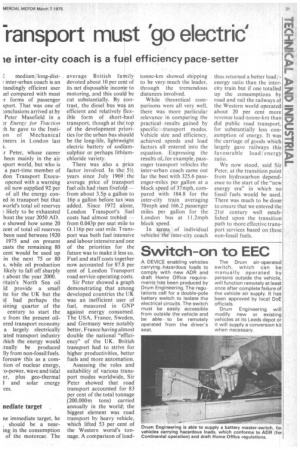"ransport must 'go electric'
Page 33

If you've noticed an error in this article please click here to report it so we can fix it.
le inter-city coach is a fuel efficiency pace-setter
medium/ long-dist: inter-urban coach is an tandingly efficient user lel compared with most .1forms of passenger sport That was one of :onclusions arrived at by Peter Masefield in a
Energr for Traction :11 he gave to the Instion of Mechanical ineers in London last k.
r Peter, whose career been mainly in the air sport world, but who is a part-time member of don Transport Execuopened with a warning oil now supplied 92 per of all the energy coned in transport but that world's total oil reserves likely to be exhausted bout the year 2050 AD. e showed how some 20 cent of total oil reserves been used between 1920 1975 and on present casts the remaining 80 cent would be used up in the next 75 or 80 s, while oil production likely to fall off sharply about the year 2000. ritain's North Sea oil Id provide a small ite for the UK but the ,d had perhaps the lining quarter of the century to start the e from the present oilered transport economy a largely electrically .ated transport industry rhich the energy would ,tually be produced Ity from non-fossil fuels. foresaw this as a corndon of nuclear energy, -o-power, wave and tidal Cr, plus geo-thermal 1 and solar energy • ces.
nediate target
ne immediate target, he , should be a nearing in the consumption of the motorcar. The average British family devoted about 10 per cent of its net disposable income to motoring, and this could be cut substantially. 13y contrast, the diesel bus was an efficient and relatively flexible form of short-haul transport, though at the top of the development priorities for the urban bus should be the long-life, lightweight electric battery of sodiumsulphur or perhaps lithiumchloride variety.
There was also a price factor involved. In the 51/2 years since July 1969 the average price of transport fuel oils had risen fivefold from about 3.5p a gallon to 16p a gallon before tax was added. Since 1972 alone, London Transport's fuel costs had almost trebled — from 0.043p per seat mile to 0.116p per seat mile. Transport was both fuel intensive and labour intensive and one of the priorities for the future was to make it less so. Fuel and staff costs together now accounted for 87.8 per cent of London Transport road service operating costs.
Sir Peter showed a graph demonstrating that among developed countries the UK was an inefficient user of fuel, measured in GNP against energy consumed. The USA, France, Sweden, and Germany were notably better, France having almost double the national "efficiency" of the UK. British transport had to strive for higher productivities, better fuels and more automation.
Assessing the roles and suitability of various transport modes worldwide, Sir Peter showed that road transport accounted for 83 per cent of the total tonnage (200,000m tons) carried annually in the world; the biggest element was road transport by heavy vehicle, which lifted 53 per cent of the Western world's tonnage. A comparison of load tonne-km showed shipping to be very much the leader, through the tremendous distances involved.
While theoretieal comparisons were all very well, there was more particular relevance in comparing the practical results gained by specific transport modes. Vehicle size and efficiency, achieved speeds and load factors all entered into the equation. Expressing the results of, for example, passenger transport vehicles the inter-urban coach came out far the best with 325.6 passenger-miles per gallon at a block speed of 37mph, compared with 184.8 for the inter-city train averaging 70 mph and 166.2 passenger miles per gallon for the London bus at 11.2mph block speed.
In terms of individual vehicles the inter-city coach thus returned a better loadenergy ratio than the intercity train but if one totalled up the consumptions by road and rail the railways of the Western world operated about 20 per cent more revenue load-tonne-km than did public road transport, for substantially less consumption of energy. It was the carriage of goods which largely gave railways this favourable load/ energy ratio.
We now stood, said Sir Peter, at the transition point from hydrocarbon dependence to the start of the "new energy era" in which no fossil fuels would be used. There was much to be done to ensure that we entered the 21st century well established upon the transition path to more effective transport services based on these non-fossil fuels.












































































































































































